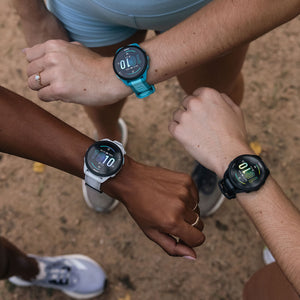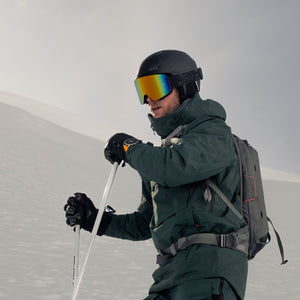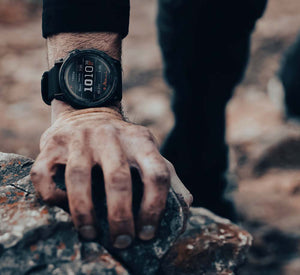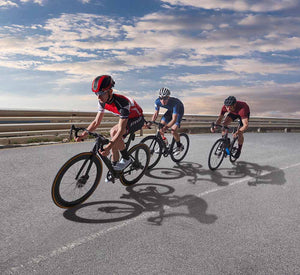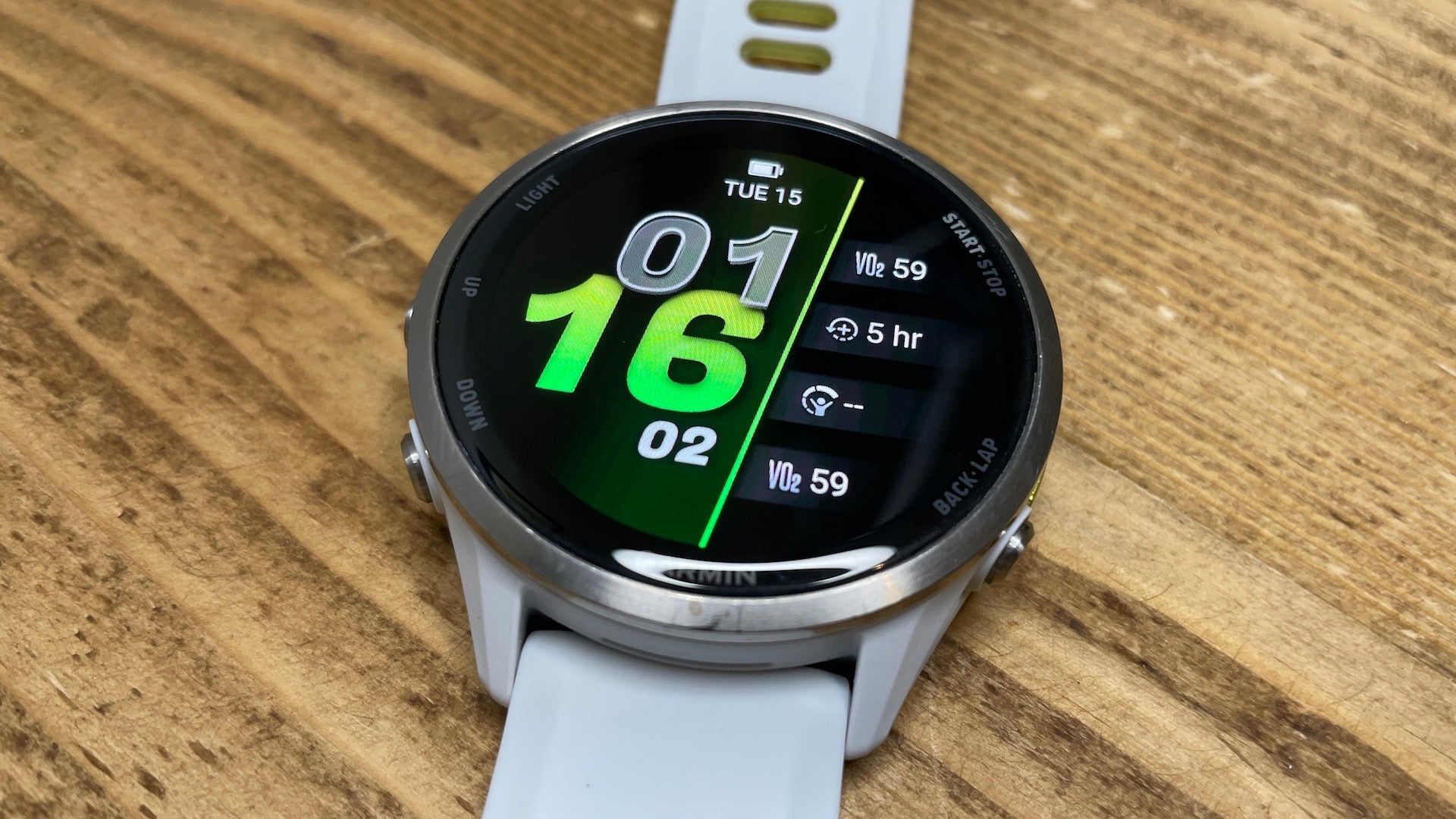
Garmin Forerunner 970 Review: Bright, Light and Packing Serious Tracking Firepower
The Forerunner 970 crams fenix-bothering features into a more wrist-friendly watch. But is this the run tracker you need?
Garmin recently released upgrades to two of its best running watches, the Forerunner 570 and the Forerunner 970. The 970 succeeds the Forerunner 965 and this latest run-focussed multisport watch is seriously starting to look like a less-rugged alternative to the Fenix series.
The new Garmin GPS watch grabs features and hardware from its chunkier Fenix stablemate: premium materials, built tough, a brighter display, the latest HR and GPS sensors, plus voice tools, speaker and that front-facing flashlight.
It adds its own new tools into the mix, too, serving up fresh running smarts including running economy, running tolerance and a host of race-day extras.
All that comes with a much bigger price tag. So are the upgrades worth it? Is it the best Garmin running watch for you? My Garmin Forerunner 970 review is here to help you decide.
Garmin Forerunner 970: Introduction and Design
The Garmin Forerunner 970 is a great-looking new Garmin watch that combines top-tier hardware and top-table features.
The case size sticks at 47 mm and the watch is a smidge thinner but slightly heavier than the 965 – 56g versus 53g. It’s still comfortable enough to wear 24-7, to unlock the full tracking potential. More on that below.
The star of the show is the bright 1.4" AMOLED display, that seriously punches up the brightness and offers ample space for all your mid-workout stats. It’s stunning, brighter than the AMOLED on the Fenix 8 and set in a sleek, lightweight titanium bezel.
It also now comes with a scratch-resistant sapphire crystal lens raising the protection from the Corning Gorilla Glass 3 DX On the 965.
The other big news: the built-in front-facing LED torch makes its way to the Forerunner 970. That’s a very welcome upgrade.
Inside, the Forerunner 970 packs Garmin’s new Elevate Gen 5 optical sensor with medically-certified ECG capability and skin temperature readouts. There’s also all systems multi-band (SatIQ) GPS with a new / different chipset from the Forerunner 965. Plus an altimeter and SpO2 sensor.
The touchscreen is snappy and responsive and works well with Garmin’s familiar five-button setup for easy control mid and post-workout.
The UI has been revamped, too. It’s now similar – but not identical – to the Fenix – and offers quicker access to menus and features. For example, it’s faster to change run settings from the run mode. Great if you remember something you want to do at the start line.
A new built-in speaker and mic now power Bluetooth calls, some limited voice controls and the ability to marshal your connected phone’s voice assistant Siri on iPhone and Google Assistant on Android.
The Forerunner 970 is water rated to 50 meters and comes with 32GB storage. Plenty enough for offline music and maps.
How I Tested the Forerunner 970
I lived with the Garmin Forerunner 970 on my wrist 24-7 for at least two months.
I clocked my daily miles with it, including some serious training runs. I travelled with it, slept with it and even used it to race the 56-mile Comrades Marathon alongside the Forerunner 570.
I put it up against some rival fitness smartwatches like the Polar Grit X2 and some much pricier and more advanced sports watches, including the new Garmin Forerunner 970 and the Garmin fenix 8 AMOLED.
I tested the AMOLED screen in all kinds of conditions, delved into the training, recovery, health and navigation features. Analyzed my training data, dug deep into the GPS tracks and used the Garmin HRM 600 chest strap to test the reliability of the optical heart rate.
After all of that, I’ve rated it for comfort, features, accuracy and battery life.
Models, Sizes & Prices
The Garmin Forerunner 970 comes in one 47mm case size and three color combinations. There’s a carbon grey DLC titanium with black case and black band, gold titanium with French grey case and french grey/indigo strap and
titanium with whitestone case and whitestone/yellow band.
If you’re not in love with the livelier colors, you can always stick with black and the 22m bands are also swappable. But I personally like the punchier design.
At launch, the Garmin Forerunner 970 price was $749.99. That’s a $150 jump up from the Forerunner 965 ($599.99) and nudges the top Forerunner closer to the cheapest AMOLED Fenix 8 ($1099.99). Incidentally, it’s almost the same as the 47mm Garmin fenix E ($799.99).
Outside of Garmin’s stable, it’s up there with the Polar Grit X2 Pro ($749.95) and pricier than the COROS Vertix 2 ($699.99).
Garmin Forerunner 970 Battery Life
The Garmin Forerunner 970 battery life has some improvements, some drops.
On paper, you now get:
- Up to 15 days in smartwatch mode – down from 23 days on the Forerunner 965.
- Up to 26 hours GPS only – down from 31 hours on the 965.
- Up to 21 hours in all systems dual frequency – up from 19 hours on the 965.
Meanwhile, the GPS plus music battery life is up across the board to 12-14 hours depending on your GPS settings. The Forerunner 965 offered just 8.5 t0 10.5 hours.
I was disappointed with the general usage battery life. In testing, with the Always on screen and the screen ramped to full brightness, I got 4 days of general usage with just one-hour’s GPS workout before I had to pop it back on charge. That’s a thirsty watch.
However, you’re paying for most of the battery life loss with that extra bright screen and you can offset some of that by tweaking the settings to lower the brightness without really sacrificing any screen readability.
On the run, with the Always On screen switched off, using the max-accuracy All Systems + multiband GPS mode, an hour’s run burned around 4%. Meanwhile, a 9-hour run in the same settings burned 39%.
If you extrapolate and take into account the burn rate speeds up when you get towards empty, that comes up around 32 hours. But I’m not sure I’d risk it on 30-hour ultra. For that, you’d likely need a Fenix.
The Garmin Forerunner battery life headlines:
- 4 days general use with 1-hr GPS workout
- A 1-hour run with All Systems + multiband GPS on average burned 4%
- The average overnight burn was 3-5%
Running, Fitness and Health Features
The Forerunner 970 offers one of the most comprehensive suites of Garmin tools across training, racing, recovery, health and smart watch smarts. And there's enough here to cater for most runners, riders and swim-bike-runners. And to seriously rival the Fenix 8.
Navigation is excellent. It retains full-color, offline maps but with improved presentation that looks great on that new bright screen. You also get dynamic round-trip routing, back to start and excellent trail tools like ClimbPro and Up Ahead that gives you forewarning of stops along a preloaded course, including aid stations.
For runners there are some interesting new metrics. Here’s a rundown:
Running economy estimates your efficiency using long-term running volume, stride length and step speed loss, aka how much you slow down when your foot hits the ground. However, it’s frustrating that you’ll need to invest in a new HRM 600 chest strap to unlock these and in practice I saw little discernible change run to run and it lacks any concrete actions to take to improve it.
Impact Load is more useful. This tries to count the true cost of your runs, flagging an increased load if your 10km was at a higher intensity or up steeper hills. On the watch you get an Impact Load Distance as well as your actual distance. So for my all out 10km PB my impact load was estimated at 11.5 miles.
Running Tolerance is another useful addition. It provides a recommended weekly maximum mileage based on a baseline from recent training. Essentially an estimate of how much your body can take without risking injury. I’m regularly running 50 mile weeks and Garmin has my tolerance closer to 70 miles which I think is probably true. I could handle more. However, there’s a worry that people might use this as a target to hit, rather than a guide.
There are some new race tools. Autolap by timing gates snaps you to the actual mile markers on official courses for routes where those virtual markers have been logged.
Essentially this provides pace set to the official markers because the splits only happen when you pass the mile or km marker on the course.
I’m a fan of the new Suggested Finish line feature that spots when you’ve forgotten to stop your watch post-race and not only reminds you but also suggests the portion of the rogue data to cut.
There’s also a new projected race time predictor. An estimate of what your race time and pace could be if you keep training well all the way through to the race date.
If you’re planning to use this as a triathlon watch, Garmin has added a Garmin Triathlon Coach serving up free, adaptive training plans tailored to your performance, recovery, and metrics. You can also do multisport workouts and switch seamlessly between disciplines.
Beyond running and workouts, Garmin also added a new mildly useful Evening Report. A spin-off for the daily Morning Report feature, this pumps out a pre-bed summary of your sleep goals, tomorrow’s workout, weather, and schedule.
Smartwatch Tools
Garmin watches lack the array of third party apps and tools you’ll find on ‘proper’ smartwatches like the Apple Watch Ultra 2. But in the sportswatch world, the brand’s smartwatch smarts are the best. And the Forerunner 970 is now even more capable.
You get the usual suite of Garmin tools: smartphone notifications, weather updates, and calendar alerts, 32GB storage for offline music with Spotify and Deezer support, plus contactless payments.
But the big new addition is the speaker and microphone which powers voice tools like offline voice control (though the list of orders you can bark is currently quite small, on-wrist calls (with a connected smartphone, there’s no cellular option here).
You can also listen to your tunes through the watch speaker, though the quality isn’t great.
Safety’s covered, too with Live Track location sharing (with a connected smartphone) and Incident Detection (a bit like Apple's Crash/Fall Detection) that can automatically share your location to emergency contacts if an incident occurs. You can also trigger this manually if you feel unsafe.
Garmin Forerunner 970 Heart Rate and GPS Accuracy
The Garmin Forerunner 970 sensor suite has been updated. It now offers multi-band GNSS (multi-frequency GPS) used in Garmin’s top-tier watches to boost tracking accuracy in dense urban areas or under tree cover. Along with Garmin’s SATIQ, that smartly adapts to your surroundings to balance accuracy and battery life.
You also get Garmin’s newest Elevate v5 sensor with ECG.
I tested the Garmin Forerunner 970 GPS accuracy and heart rate reliability against a benchmark Garmin HRM Pro+ chest strap and the top-tier Garmin fenix 8 AMOLED. I also pitted it against a selection of rivals, including the Garmin Forerunner 570, the Polar Grit X2
My test runs were mainly around semi built-up urban streets with some open sky park runs and tree-covered river paths thrown in. I also ran the 56-mile Comrades Marathon in South Africa and a few other races.
I found the accuracy for the heart rate and GPS was nicely reliable. The optical was as good as any other optical I’ve tested. The GPS handled most of my runs competently.
An example, the Comrades official distance was 55.9 miles and I logged 56.41 miles with a lot of weaving. That was also within 0.05 of a mile against the Fenix 8.
On the twisty, turny Saucony London 10km course, the Forerunner 970 registered a total distance of 10.28km. That’s great in built-up conditions. For comparison. The Fenix 8 clocked 10.25 and the Forerunner 570 logged 10.14km.
When you dig into the GPS tracks, the Forerunner 970 largely does a good job of snapping me to my routes. No watch gets this right 100% of the time and there are some sections through buildings. But the overall GPS accuracy for the 970 has been happily reliable.
(Image above shows GPS tracking in purple for FR 960 and blue for the fenix 8).
It’s a similar story on heart rate accuracy. The optical performance was as good as any rivals I’ve tested, if not better. Not always a 100% match for my test chest strap but generally solid.
Bottom Line: Should You Buy the Garmin Forerunner 970?
The Garmin Forerunner 970 is more than a running watch, it’s an impressively capable multisport watch with a set of skills that focus heavily on running.
The great balance of tracking, training health and smart tools and premium materials is excellent and aside from the tougher, bigger battery Fenix 8, the Forerunner 970 is unrivaled.
Suunto, Polar and Coros’ AMOLED watches are cheaper than the Forerunner 970 but you’re not getting the breadth, depth or quality of design or tools to match Garmin’s top Forerunner.
The only real trade offs are that shorter battery (a limiter if you’re doing the longest ultras), the fact it only comes in one size (we’d like to see a smaller option for daintier wrists) and that rising price.
But if your budget stretches, this is the most capable running watch you can buy right now.
Forerunner 970 vs 965: The Forerunner 970 is a marked improvement on the 965 with some updates like the flashlight that are certainly appealing. But for out and out value, the Forerunner 965 is the better option. You get most of the tracking power of the 970 and a longer battery life. If you can hunt down a deal, it’s still a great watch.
Forerunner 970 vs 570: If you want a built-in torch offline mapping, ECG, a longer battery life and a tougher display, the 970 is the way to go. If you don’t mind sacrificing those features, want a smaller watch or you just want the core sports tracking performance on a budget, the Forerunner 570 delivers.
About Journalist Kieran Alger
Co-founder of The Run Testers, Kieran Alger is an experienced journalist who has spent more than a decade testing running gear. Regularly found wearing four GPS running watches at once, if it claims to make you run better or enjoy running more, he has probably tested it. He's a borderline obsessed runner with more than 50 marathon and multiple ultra finishes. In 2022, he became the first person to run Europe's river Danube from sea to source, a measly 1,830 miles in 66 days. And still had time to test running gear.
Check him out on Instagram or his YouTube Channel!

